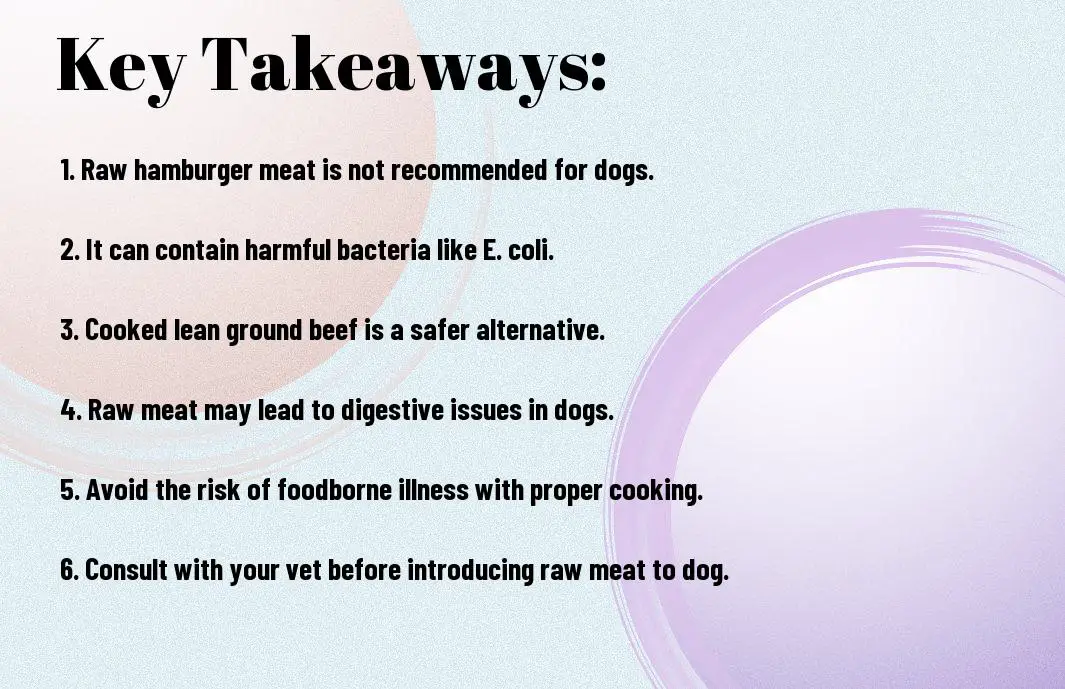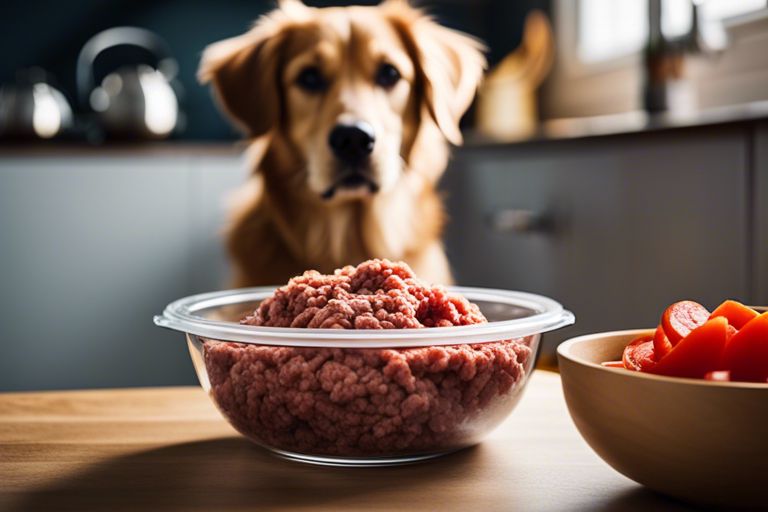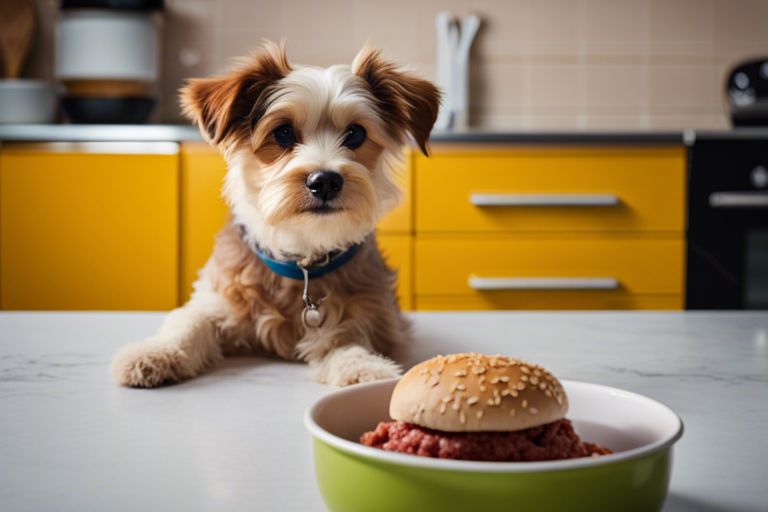Many dog owners often wonder about the safety of feeding their furry companions raw hamburger meat. While dogs are known to be omnivores, their digestive systems can be sensitive to certain foods. Raw hamburger meat, in particular, poses various risks that pet owners should take into consideration before including it in their dog’s diet.
As far as raw meat, including hamburger meat, there is a potential for harmful bacteria such as E. coli and Salmonella to be present. These bacteria can not only cause gastrointestinal issues in dogs but also pose health risks to humans handling the meat. Additionally, raw hamburger meat may not provide the necessary nutrients that a balanced dog diet requires, potentially leading to deficiencies over time. It is crucial to consult with a veterinarian before introducing raw meat into your dog’s diet to ensure their overall health and well-being.
While some dog owners may choose to feed their pets a raw diet, it is imperative to weigh the risks and benefits carefully. In the case of raw hamburger meat, it is generally recommended to opt for cooked alternatives to eliminate the risk of foodborne illnesses. Ultimately, the health and safety of your beloved canine companion should always be the top priority when making decisions about their diet and nutrition.

Key Takeaways:
- Consult your vet: Before incorporating raw hamburger meat into your dog’s diet, it is crucial to consult with your veterinarian to ensure it is safe and beneficial for your furry friend.
- Potential risks: Raw hamburger meat can pose risks of bacterial contamination, such as salmonella and E. coli, which can be harmful to your dog’s health.
- Precautions: If you choose to feed your dog raw hamburger meat, make sure it is fresh, high-quality meat sourced from a reliable butcher, and handle it properly to minimize the risk of contamination.


Exploring Canine Nutrition
Nutritional Requirements for Dogs
Some dog owners may wonder about the specific nutritional requirements for their furry friends. Canine nutrition is a crucial aspect of ensuring your dog’s overall health and well-being. Dogs, like humans, require a balanced diet to meet their energy needs, support their growth and development, and maintain a healthy weight.
When considering formulating a proper diet for your dog, it’s crucial to consider their age, breed, size, and activity level. Puppies, for example, have different nutritional needs than adult dogs, while large breeds may require a diet tailored to support their bone and joint health. Consulting with a veterinarian or a professional pet nutritionist can help you determine the best diet for your dog.
Understanding the nutritional requirements for dogs is the first step in providing them with a healthy diet. By ensuring that your furry companion receives the right balance of nutrients, you can help them live a long, active, and happy life.
The Role of Protein in a Dog’s Diet
Canine diets should be rich in high-quality protein sources to support their muscle development, immune function, and overall health. Protein is crucial for dogs of all ages, as it provides the building blocks for cells, tissues, enzymes, and hormones. Without an adequate protein intake, dogs may experience muscle wasting, reduced immunity, and poor coat quality.
Diet plays a crucial role in meeting a dog’s protein requirements. Commercial dog foods often contain a balanced mix of proteins from sources like meat, poultry, fish, and plant-based ingredients. While some dog owners opt for homemade diets, it’s important to ensure that these diets provide enough protein and crucial amino acids to meet your dog’s needs.
Another crucial aspect to consider is the digestibility of the protein sources in your dog’s diet. High-quality proteins are more easily digested and absorbed, ensuring that your dog can utilize the nutrients effectively. Choosing premium dog food brands with reputable protein sources can help you provide your canine companion with the protein they need.
Vitamins and Minerals: Their Importance
Another key element of canine nutrition is the importance of vitamins and minerals in a dog’s diet. Dogs require a wide range of vitamins and minerals to support various bodily functions, such as bone health, immune function, and cell metabolism. These crucial nutrients play a crucial role in maintaining overall health and preventing nutrient deficiencies.
Canine diets should include a balanced mix of vitamins and minerals to ensure that your dog receives all the nutrients they need. Vitamin-rich foods like fruits and vegetables can provide crucial vitamins such as vitamin A, C, and K, while minerals like calcium, phosphorus, and zinc are vital for bone health and immune function. Choosing dog foods that are formulated to meet AAFCO (Association of American Feed Control Officials) standards can help you ensure that your dog’s diet is nutritionally complete.
Dogs rely on a consistent intake of vitamins and minerals to support their growth, development, and overall well-being. By paying attention to the vitamin and mineral content of your dog’s diet, you can help them thrive and lead a healthy life.

Raw Feeding and the BARF Diet
Basics of Biologically Appropriate Raw Food (BARF)
One of the popular choices for raw feeding is the Biologically Appropriate Raw Food (BARF) diet. This diet is based on the principle that dogs should eat a diet that closely resembles what their ancestors would have consumed in the wild. The BARF diet typically consists of raw meat, bones, fruits, vegetables, and sometimes dairy products. It aims to provide dogs with a nutritionally balanced diet that is rich in natural enzymes, vitamins, and minerals.
When following the BARF diet, it is crucial to ensure that the ingredients are fresh and of high quality. It is also crucial to maintain the correct balance of nutrients in your dog’s diet to prevent any nutritional deficiencies or imbalances. Many pet owners who choose the BARF diet opt to prepare their dog’s meals at home to have better control over the ingredients and portion sizes.
Proponents of the BARF diet believe that feeding dogs a biologically appropriate diet can lead to various health benefits, including improved digestion, healthier skin and coat, increased energy levels, and better weight management. However, it is crucial to consult with a veterinarian or a pet nutritionist before switching your dog to a raw diet to ensure that it meets all of your dog’s nutritional needs.
Potential Benefits of Raw Feeding
Food: A raw diet is believed to promote better digestion in dogs, as it is more in line with their natural dietary preferences. Raw food diets are often rich in enzymes and probiotics, which can aid in the digestion process and improve nutrient absorption. Additionally, some dog owners have reported that their pets have smaller, firmer stools when on a raw diet, indicating better digestion and nutrient utilization.
Understanding the potential benefits of raw feeding can help you make an informed decision about whether this diet is suitable for your dog. While there are many reported benefits of raw feeding, it is crucial to consider your dog’s individual needs and consult with a professional before making any dietary changes. With the right guidance and planning, raw feeding can be a nutritious and fulfilling option for your furry friend.
Risks of Raw Hamburger Meat
Bacterial Contamination Concerns
All pet owners should be aware of the potential risks associated with feeding raw hamburger meat to their dogs. One of the primary concerns is bacterial contamination. Raw hamburger meat, just like any other raw meat, can be a breeding ground for harmful bacteria such as Salmonella, E. coli, and Listeria. These bacteria can cause severe gastrointestinal issues in dogs, including vomiting, diarrhea, and in some cases, more serious complications that may require veterinary care.
Furthermore, handling raw meat improperly can lead to cross-contamination, spreading harmful bacteria to other surfaces in your kitchen and increasing the risk of infection for both your dog and your family members. It’s important to follow strict food safety protocols when handling raw hamburger meat to minimize the risk of bacterial contamination.
If you choose to feed your dog raw hamburger meat, it’s crucial to source high-quality, fresh meat from reputable suppliers to reduce the risk of bacterial contamination. Additionally, consider consulting with your veterinarian to ensure that your dog’s diet is balanced and safe for their consumption.
Parasites and Diseases in Raw Meat
With raw hamburger meat, there is also a risk of parasites and diseases that can be transmitted to your dog. Raw meat can harbor parasites such as Toxoplasma gondii and Echinococcus multilocularis, which can cause serious health issues in dogs, including organ damage and neurological complications. In addition, raw meat may contain bacteria such as Campylobacter and Clostridium perfringens, which can lead to gastrointestinal infections and other health problems.
It’s important to be aware of the potential risks associated with feeding raw hamburger meat to your dog and take necessary precautions to protect their health. Consider consulting with your veterinarian to discuss safer alternatives that provide the necessary nutrients for your dog’s well-being without exposing them to unnecessary health risks.
When feeding raw hamburger meat to your dog, always ensure that the meat is fresh, properly handled, and sourced from reputable suppliers to minimize the risk of parasites and diseases. Monitor your dog closely for any signs of illness or unusual behavior after consuming raw meat and seek veterinary care if necessary.
Bone Fragments and Choking Hazards
Bone fragments and choking hazards are additional risks associated with feeding raw hamburger meat to your dog. Bacteria can also be present on bones, posing a risk of contamination and potential health issues for your dog. Additionally, bone fragments in raw meat can splinter and cause choking hazards or injury to your dog’s digestive tract.
It’s crucial to be cautious when feeding raw hamburger meat with bones to your dog and closely monitor them while they are eating to prevent any choking incidents. Consider offering safer alternatives such as raw meat without bones or processed dog food specifically designed to meet your dog’s nutritional needs without the risk of bone fragments.
If you choose to feed your dog raw hamburger meat with bones, be sure to select bones that are appropriate for your dog’s size and chewing habits to minimize the risk of choking hazards. Always supervise your dog while they are chewing on bones to ensure their safety and prevent any potential injuries.
Nutritional Imbalance Issues
It is important to consider the nutritional imbalance issues that may arise from feeding raw hamburger meat to your dog. While raw meat can be a source of protein and important nutrients, it may not provide a complete and balanced diet for your dog. Without the addition of other food groups such as fruits, vegetables, and grains, your dog may be at risk of deficiencies in vitamins, minerals, and other important nutrients.
Feeding raw hamburger meat as the sole source of nutrition for your dog can lead to long-term health issues and nutrient deficiencies that may affect their overall well-being. It’s crucial to consult with your veterinarian or a pet nutritionist to ensure that your dog’s diet is well-rounded and meets all of their nutritional needs to support their health and vitality.
Consider incorporating a variety of nutrient-rich foods into your dog’s diet to prevent nutritional imbalance issues and ensure that they are receiving a balanced and complete diet. Work with your veterinarian to create a customized meal plan that takes into account your dog’s age, breed, size, and activity level to provide them with the necessary nutrients for optimal health.
Safe Handling of Raw Meat
Despite the temptation to share your raw hamburger meat with your furry friend, it’s crucial to handle raw meat safely to prevent the risk of contamination. Raw meat, including hamburger meat, can harbor harmful bacteria such as E. coli and Salmonella, which can make both humans and dogs sick if consumed. To ensure the safety of both you and your pet, it’s necessary to follow best practices for handling raw meat.
Best Practices for Raw Meat Preparation
One of the most important practices when preparing raw meat is to keep it separate from other foods, especially those that are meant to be consumed raw, such as fruits and vegetables. Use separate cutting boards, utensils, and containers to avoid cross-contamination. Wash your hands thoroughly with soap and water before and after handling raw meat to prevent the spread of bacteria.
Cooking meat to the appropriate internal temperature is also crucial in killing any harmful bacteria. Use a meat thermometer to ensure that the internal temperature of the meat reaches at least 160°F (71°C) for ground beef, including hamburger meat. Avoid partially cooking meat and then refrigerating or freezing it, as this can allow bacteria to survive and multiply.
When marinating raw meat, make sure to do so in the refrigerator, not on the countertop. If you plan to use the marinade as a sauce, reserve a portion before adding the raw meat to avoid contamination. Lastly, refrigerate or freeze raw meat promptly to slow down bacterial growth. Avoid leaving raw meat out at room temperature for an extended period, as this can increase the risk of foodborne illness.
Storage and Thawing Techniques
One key aspect of safely handling raw hamburger meat is proper storage and thawing techniques. Store raw meat in the refrigerator at 40°F (4°C) or below to prevent bacteria from multiplying. If you don’t plan to use the meat within a few days, consider freezing it for longer storage. Make sure to wrap the meat tightly to prevent freezer burn.
With respect to thawing frozen raw meat, the safest methods are in the refrigerator, in cold water, or in the microwave. Avoid thawing meat at room temperature, as this can allow bacteria to grow. If using the refrigerator method, place the meat on a tray or plate to catch any drips and prevent cross-contamination with other foods.
The refrigerator method requires more time, but it is the safest way to thaw raw meat. Plan ahead and allow enough time for the meat to thaw completely in the refrigerator before cooking. By following these storage and thawing techniques, you can ensure the safety of your raw hamburger meat and minimize the risk of foodborne illness for both you and your beloved canine companion.
Transitioning to a Raw Meat Diet
Keep in mind that transitioning your dog to a raw meat diet should be done gradually to avoid any digestive upsets. Switching their food suddenly can lead to stomach issues such as diarrhea or vomiting.
Start by incorporating a small amount of raw hamburger meat into your dog’s current diet and gradually increase the portion over the course of a week or two. Monitor your dog’s stool and overall well-being during this transition period.
It’s crucial to provide a balanced diet for your canine companion. Raw hamburger meat alone is not sufficient as it lacks crucial nutrients like calcium. Consider adding supplements or other sources of nutrients to ensure your dog maintains a healthy and balanced diet.
Consult with your veterinarian before making any drastic changes to your dog’s diet, especially if they have any underlying health conditions or special dietary needs. A professional can provide guidance on how to effectively transition your dog to a raw meat diet while meeting all their nutritional requirements.
Recall, every dog is different, and what works for one may not work for another. Pay attention to your dog’s response to the new diet and make adjustments as needed to ensure they thrive on their raw meat plan.
FAQ
Q: Can my dog eat raw hamburger meat?
A: No, it is not recommended to feed your dog raw hamburger meat due to the risk of bacterial contamination such as E. coli and Salmonella.
Q: What are the potential risks of feeding raw hamburger meat to my dog?
A: Raw hamburger meat can contain harmful bacteria that can cause food poisoning in dogs, leading to symptoms such as vomiting, diarrhea, and potentially more severe complications.
Q: How should I prepare hamburger meat for my dog if I want to feed it to them?
A: It is best to thoroughly cook the hamburger meat before feeding it to your dog to eliminate any potential bacteria and ensure it is safe for consumption.
Q: What are some alternatives to raw hamburger meat for my dog?
A: You can feed your dog cooked lean meats such as chicken, turkey, or beef as a safer alternative to raw hamburger meat. Make sure to remove any bones and seasonings before feeding.
Q: How can I ensure my dog is getting a balanced diet if I avoid feeding them raw hamburger meat?
A: Consult with your veterinarian to create a balanced diet plan for your dog that includes a mix of high-quality commercial dog food, cooked meats, vegetables, and other appropriate supplements to meet their nutritional needs.
